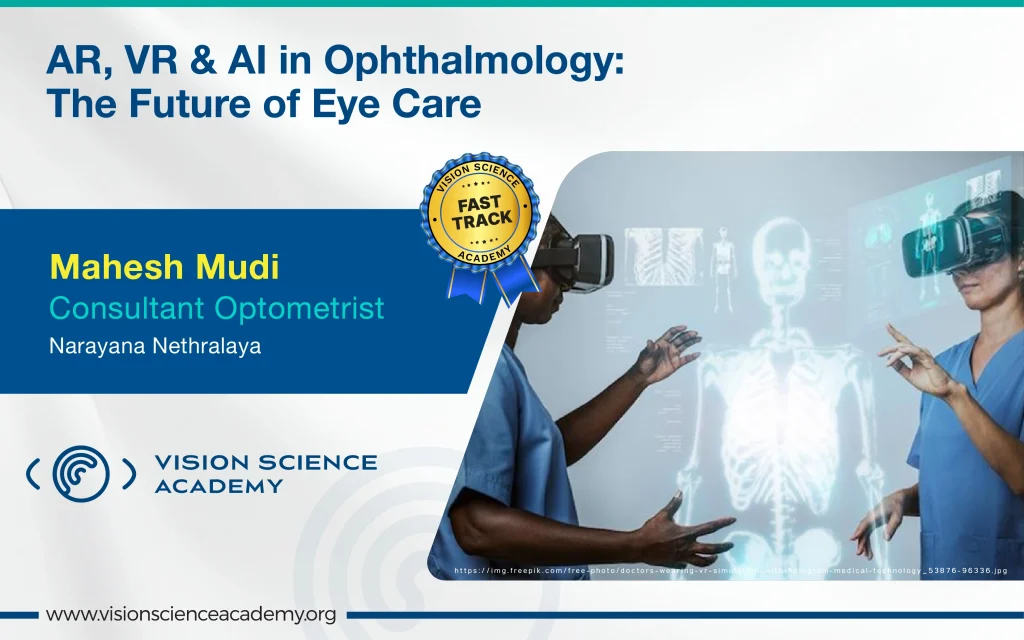Mahesh Mudi, Fellowship in Paediatric Optometry, Binocular Vision, and Cerebral Vision Impairment
Consultant Optometrist, Narayana Nethralaya, Bengaluru, India
Augmented Reality (AR), Virtual Reality (VR), and Artificial Intelligence (AI) are revolutionising ophthalmology, driving unprecedented precision, efficiency, and personalisation in surgery, diagnosis, and treatment, shaping the future of patient care.
- Augmented Reality: A New Vision for Surgical Precision and Patient Education
Augmented Reality (AR) technology overlays virtual details on the real world, allowing ophthalmologists to see more clearly during diagnosis and surgery. AR has been particularly innovative in surgical navigation and intraoperative guidance, helping doctors become more accurate while doing delicate eye treatments.
Key Applications of AR in Ophthalmology:
- Intraoperative Surgical Assistance: AR systems can display critical data, such as vascular maps or retinal imaging, straight into the surgeon’s field of vision. This makes it easier to navigate during intricate procedures when accuracy is crucial, such as vitrectomy or retinal detachment repair. In contrast to conventional techniques, AR-assisted retinal surgery demonstrated a substantial decrease in surgical mistakes and better patient outcomes.(1,7)
- Virtual Reality: Transforming Training and Patient Rehabilitation
While AR assists in real-time surgical procedures, Virtual Reality (VR) is making significant strides in education.
Applications of VR in Ophthalmology:
- Surgical Training: Virtual reality enables ophthalmologists to perform complex procedures in a safe, immersive environment, allowing trainees to practice cataract surgeries, retinal procedures, and corneal transplants without risk to patients. VR-based training enhances precision and efficiency, with participants completing procedures 20% faster and making 30% fewer errors compared to traditional methods, revolutionizing surgical education.(2)
- Visual Field Testing and Diagnosis: Virtual reality is transforming glaucoma diagnostics by enabling precise visual field assessments. VR-based testing enhances early detection with an 85% sensitivity rate, outperforming traditional methods at 70%, improving accuracy and patient outcomes. (3,6)
- Artificial Intelligence: The Brain Behind Smarter Diagnosis and Personalised Treatment
AI has become a vital tool in ophthalmology, helping with diagnosis, treatment planning, and even surgery by utilising enormous volumes of data from imaging devices and patient records. AI-driven algorithms are getting better at evaluating fundus photos, OCT scans, and retinal imaging to find early indicators of eye disorders with amazing precision.(6)
Applications of AI in Ophthalmology:
- Early Detection of Retinal Diseases: AI-driven retinal imaging enhances early disease detection, identifying conditions like diabetic retinopathy, AMD, and retinal vein occlusion with high accuracy. FDA-approved IDx-DR diagnoses diabetic retinopathy with 97% sensitivity and 87% specificity, outperforming general practitioners. Clinical trials show AI screening achieves 94% accuracy, proving its reliability for early diagnosis, especially in underserved areas.(4,6)
- AI in Glaucoma Management: AI-driven optic nerve analysis enhances glaucoma management by detecting early signs of damage with 95% accuracy, matching expert ophthalmologists. Trained on 30,000 images, this technology enables timely intervention, reducing the risk of vision loss.(6)
- AI-Assisted Surgery: Even robotic surgical devices are using AI to help surgeons execute more accurate procedures. Throughout surgery, AI systems continually evaluate data and adapt to variations in the operative area. Robotic retinal surgery is a potential example, where AI can provide real-time hand guidance to the surgeon to guarantee the best results.
- The Future of Ophthalmology: A Harmonised Approach
AR, VR, and AI are revolutionising ophthalmology by improving diagnosis, treatment, and rehabilitation. AI enables precise detection of conditions like diabetic retinopathy, while VR aids real-time therapy, and AR enhances laser treatment accuracy, driving patient-centered care.(6)
Conclusion
AI, VR, and AR are reshaping ophthalmology, enabling precise diagnosis, minimally invasive procedures, and improved surgical outcomes, with ophthalmologists driving this technological future.
References:
- JAMA Ophthalmology. (2022). Augmented reality-assisted retinal surgery: Impact on surgical errors and patient outcomes. JAMA Ophthalmology. https://doi.org/10.1001/jamaophthalmol.2022.1784
- Ophthalmology Times. (2022). Virtual reality-based surgical training for ophthalmologists: Improved speed and accuracy in cataract surgery and more. Ophthalmology Times. Retrieved from https://www.ophthalmologytimes.com
- Investigative Ophthalmology & Visual Science. (2021). Enhancing early detection of glaucoma using virtual reality-based visual field testing: A comparison of sensitivity with traditional methods. Investigative Ophthalmology & Visual Science, 62(4), 2151-2157. https://doi.org/10.1167/iovs.62.4.2151
- The Lancet Digital Health. (2020). Artificial intelligence for diabetic retinopathy screening: A clinical trial of IDx-DR in underserved communities. The Lancet Digital Health, 4(12), e775-e783. https://doi.org/10.1016/S2589-7500(20)30252-X
- Ophthalmology Times. (2022). AI-driven personalized treatment protocols: Revolutionizing patient care in ophthalmology. Ophthalmology Times. Retrieved from https://www.ophthalmologytimes.com
- Li T, Li C, Zhang X, Liang W, Chen Y, Ye Y and Lin H (2021) Augmented Reality in Ophthalmology: Applications and Challenges. Front. Med. 8:733241. https://doi:10.3389/fmed.2021.733241
- JAMA Ophthalmol. 2022 February 01; 140(2): 177–178. https://doi:10.1001/jamaophthalmol.2021.5745.
